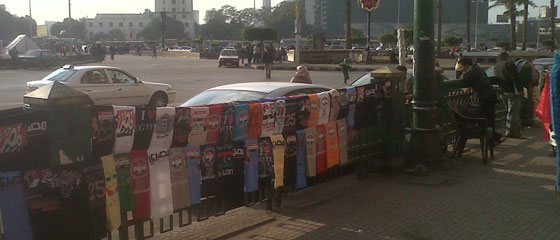
Tahrir Square
Guide to visiting Tahrir square, including intro, practicalities, the location and history of Tahrir Square
On January 25th 2011 the world’s news media turned its cameras on Egypt as the masses gathered to demonstrate against the 30 year rule of Egyptian dictator, Hosni Mubarak.
Later, the 18 days of protests that lead to Mubarak’s resignation would be lauded for the way in which they were carried out, largely peacefully and at times with a festive atmosphere.
Although Egyptian protesters were to take to the streets across the county, Cairo’s Tahrir Square was the resounding spotlight, the epicentre of the unfolding story and the relentless beating heart of the revolution.
Today it seems everybody has heard of Tahrir Square, but this central Cairo expanse – often as full of cars as it is of people – has been synonymous with freedom, reform and revolution long before the events of 2011.
Visiting Tahrir Square (Updated 4th January 2012)
Tahrir is easily reached by taking the Cairo Metro to Sadat Station located beneath the Square. Alternatively one can take a taxi or walk from almost anywhere in downtown Cairo or along the central cornice.
Al Kadr Al Aini – the main approach from the south – remains blockaded in places with a strong military presence. Walking from this side of the square will require a small diversion out to the Nile and back past the front of the Intercontinental Semiramis Hotel.
Day to day the square is largely free of protesters except for the central roundabout which maintains an ever-present contingent of tents, flags and people.
This often changes on Fridays (after Friday prayer) when the protests start a fresh and Caireans from all over the city join the bodies in the square once more.
For the rest of the week, the area is seemingly peaceful with flags and t-shirts on sale, hawkers touting for tourist dollars and the usual ubiquitous traffic congestion of Cairo.
Please be aware that the situation in and around the square is both changeable and volatile and travellers should check for updates (see resource box) before visiting and depart the square at the first sign of trouble.
If you get peckish during your visit why not sample the meatballs at Tahrir Table, Cairo's only Swedish restaurant located on the square. Aside from the quality munch, the restaurant also hosts revolution related galleries on the premises (see resource box below for details).
Location of Tahrir Square
Tahrir Square is the public square of Downtown Cairo, located on the East Bank of the river Nile across the water from the upmarket island borough of Zamalek.
The main arteries of downtown Cairo converge here at Tahrir Square.
These include Talaat Harb (the central shopping street and location of much of the city’s budget accommodation), Al Kadr Al Aini (one of the oldest Streets in downtown Cairo and home to many prestigious buildings and institutions) and Meret Basha (location of the Egyptian Museum just a short walk away)
The National Democratic Party Headquarters (NDP) is also located close by as are the Arab League Headquarters and the Mogamma government building.
Sadat Metro Station – located beneath the square - is at times as busy as the surface of the road above and is serviced by both the El-Moubib/Shobra line and the El-Marg/Helwan line.
History of Tahrir Square
Tahrir square was a patch of desert on the east bank of the River Nile until the 19th Century, when the Khedive Ismail (1863 – 1879) began developing modern Cairo to his vision of ‘Paris by the Nile’.
Originally given the name Ismaili square after its founder, Tahrir encompassed the central location in the new Ismaili district that only later would become known as downtown Cairo.
The square saw it’s first staged protests on February 11 1946 against British Colonial rule, exactly 64 years to the day prior to Mubarak’s resignation.
Following the British killing of some 50 Egyptian policemen in the city of Ismailia, January 25th 1952 saw another set of protests take place in Tahrir square.
The arson of what would become known as ‘Black Saturday’ ensued, during which some 750 buildings around downtown Cairo were burnt to the ground.
The British recognised that their grip on the country was slipping and later that same year Nasser’s free officers seized control in July’s military coup.
Shortly afterwards President Nasser gave Ismaili square its new name in recognition of the pivotal role it has played in the revolution, ‘Tahrir’ meaning liberation.
For More Information:
Harvard Press - For a full, fascinating history of Tahrir Square
Wiki Pedia - More on the life of Ismaili Pasha
Al Jazeera - The latest updates from Tahrir
Tahrir Table - Meatballs anyone? The Swedish Restaurant making headlines in Tahrir




